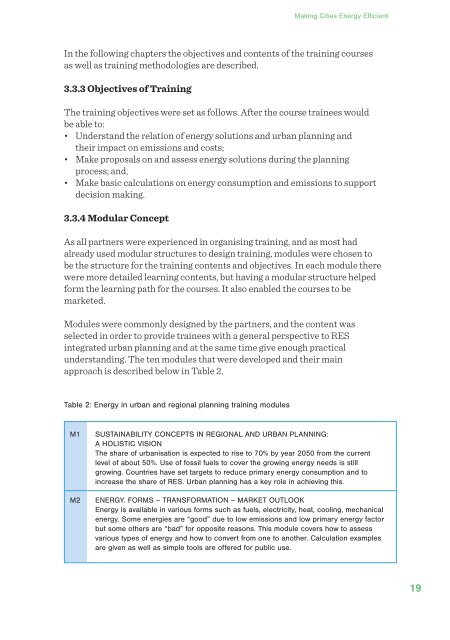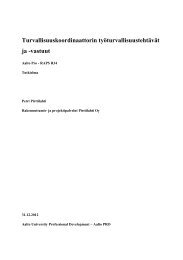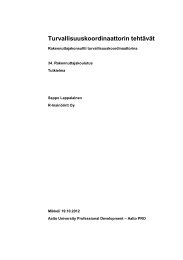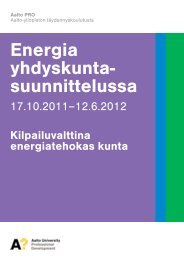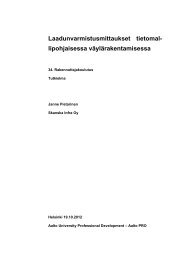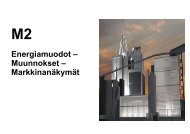Urban and Regional Planning adopting RES - Sitra
Urban and Regional Planning adopting RES - Sitra
Urban and Regional Planning adopting RES - Sitra
You also want an ePaper? Increase the reach of your titles
YUMPU automatically turns print PDFs into web optimized ePapers that Google loves.
Making Cities Energy Efficient<br />
In the following chapters the objectives <strong>and</strong> contents of the training courses<br />
as well as training methodologies are described.<br />
3.3.3 Objectives of Training<br />
The training objectives were set as follows. After the course trainees would<br />
be able to:<br />
• Underst<strong>and</strong> the relation of energy solutions <strong>and</strong> urban planning <strong>and</strong><br />
their impact on emissions <strong>and</strong> costs;<br />
• Make proposals on <strong>and</strong> assess energy solutions during the planning<br />
process; <strong>and</strong>,<br />
• Make basic calculations on energy consumption <strong>and</strong> emissions to support<br />
decision making.<br />
3.3.4 Modular Concept<br />
As all partners were experienced in organising training, <strong>and</strong> as most had<br />
already used modular structures to design training, modules were chosen to<br />
be the structure for the training contents <strong>and</strong> objectives. In each module there<br />
were more detailed learning contents, but having a modular structure helped<br />
form the learning path for the courses. It also enabled the courses to be<br />
marketed.<br />
Modules were commonly designed by the partners, <strong>and</strong> the content was<br />
selected in order to provide trainees with a general perspective to <strong>RES</strong><br />
integrated urban planning <strong>and</strong> at the same time give enough practical<br />
underst<strong>and</strong>ing. The ten modules that were developed <strong>and</strong> their main<br />
approach is described below in Table 2.<br />
Table 2: Energy in urban <strong>and</strong> regional planning training modules<br />
M1<br />
M2<br />
SUSTAINABILITY CONCEPTS IN REGIONAL AND URBAN PLANNING:<br />
A HOLISTIC VISION<br />
The share of urbanisation is expected to rise to 70% by year 2050 from the current<br />
level of about 50%. Use of fossil fuels to cover the growing energy needs is still<br />
growing. Countries have set targets to reduce primary energy consumption <strong>and</strong> to<br />
increase the share of <strong>RES</strong>. <strong>Urban</strong> planning has a key role in achieving this.<br />
ENERGY. FORMS – TRANSFORMATION – MARKET OUTLOOK<br />
Energy is available in various forms such as fuels, electricity, heat, cooling, mechanical<br />
energy. Some energies are “good” due to low emissions <strong>and</strong> low primary energy factor<br />
but some others are “bad” for opposite reasons. This module covers how to assess<br />
various types of energy <strong>and</strong> how to convert from one to another. Calculation examples<br />
are given as well as simple tools are offered for public use.<br />
19


